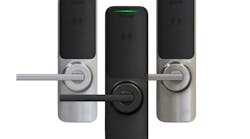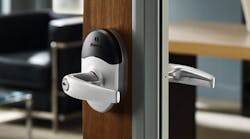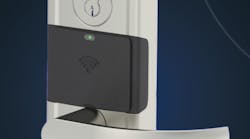At its core, access control is a fancy way of saying security. A locked door is the original form of access control.
For places that require increased security, such as offices, stores, hospitals and government installations, electronic access control (EAC) has been the security method of choice. Now, with the COVID-19 pandemic speeding up the demand for touchless doors, the market for EAC only will broaden.
Peter Boriskin, chief technology officer of ASSA ABLOY Americas, says wireless systems are a natural solution to add or expand EAC at a facility.
“The challenge is how do I manage all those doors and drawers and all those different locations without running miles of conduit and power supplies?” he asks. “Of course, wireless is the most efficient, economical and fastest way to get going.”
Jacob Myers, who is president of CM Security Solutions in San Antonio, agrees. He says he and his company have installed wireless EAC systems for eight years.
“For us, it was a no-brainer,” he says of moving into that market. “If you’re offering a wireless option and bring that to the table, where you can eliminate 50 percent of labor costs, it’s a huge selling point, especially for small business.”
The Basics
Like anything, wireless EAC has its own jargon. More than likely, you’ve heard of Bluetooth. Many locks, card readers and even credentials have the term affixed to the product sheet, and that trend will continue, because just about everyone carries a cellphone and just about every cellphone has Bluetooth connectivity built in. You typically access a Bluetooth lock or reader through your phone.
Simply, Bluetooth is a form of wireless communication, like Wi-Fi, but intended for closer range communication, such as that between a cellphone and lock. A variation, known as Bluetooth Low Energy (BLE), is meant for low-power applications, so when you see a Bluetooth door lock, for example, it almost certainly will have BLE built in. Most are standard retrofits that include batteries—no wiring necessary—but that’s also why BLE is crucial, because it prevents a power drain at the lock.
(Don’t confuse Bluetooth with near field communication [NFC], which is another wireless technology that nearly every new cellphone also has. The two technologies are similar but not the same.)
Another term that isn’t as well-known yet is cloud computing. It’s been around but has become more mainstream in the security industry in the past five years or so. Cloud computing basically means that software, data or files exist on a remote server rather than on a nearby device. Think of the difference between Netflix and a downloaded copy of a movie: Netflix is an example of cloud computing, because the movie exists only on Netflix’s server.
The concept is the same in the security industry. Rather than requiring an end user to have a computer and software on premises to manage access control, a cloud-based EAC system can be managed through a device anywhere. (Note: Cloud-based EAC software can manage either a wired or wireless system.) Besides reducing the cost of a facility’s infrastructure, this arrangement can improve security, says Jeff Perri, president and COO of ProdataKey, because cloud-based software can be updated in real time.
“If there’s any sort of malware that might be a threat to other infrastructure, we can actually develop against that before it becomes a threat,” he says. “It’s difficult if not impossible to do that with an on-prem solution,” because software updates would have to be downloaded first to take effect.
Gateway to Access Control
Finally, there’s the gateway. The gateway, or hub, is the linchpin of a more sophisticated EAC system, connecting locks, door controllers and access control software, whether that’s in an on-site computer or in the cloud, through an end user’s internet service. Wireless gateways use wireless communication to shuttle information, such as an audit trail, back and forth, but they also typically put the lie to a system being completely “wireless.” Gateways require power, either from an uninterrupted power supply, such as a wall plug, or a Power over Ethernet (PoE) connection, which requires Cat-5/6 Ethernet cable.
The gateway is essentially the router of a wireless EAC system. In fact, depending on the wireless system and locks installed, some gateways ARE a facility’s routers. You simply “discover” the lock, or establish a connection between the router and the lock, through the EAC software as you would, say, a wireless home printer and a router, and—presto—you have a wireless EAC system.
Several manufacturers, however, provide dedicated wireless security gateways, although for the most part, they’re part of a closed system. In other words, they communicate only with locks from the same company.
Some gateways allow for Bluetooth communication between the lock and the gateway, but most use a different wireless protocol from a standard Wi-Fi router—802.15.4, instead of 802.11. This provides several benefits, according to Dan Stewart, business development manager at BEST Access Solutions.
“Security access control requires the need for speed, if I might throw out a cliché,” he explains.
A dedicated gateway allows for real-time transfer of data to and from a lock without potentially being overburdened by internet traffic, which is why some customers might want to separate their security system from their communications network. “802.15.4 shares the same air space as Wi-Fi and can operate alongside those routers, but they provide quicker communication,” Stewart says. “This can be crucial during a lockdown situation at a school, for example.
Another benefit: “They’re not as power-hungry,” he adds.
Easy Does It
For locksmiths who might be intimidated by going electric, Myers and others have two words of advice: Don’t be. Wireless EAC systems are naturally easier to install than are their wired counterparts and, obviously, don’t require as much time. However, manufacturers have made their products even easier to install by adding features, such as plug-and-play capability and more-intuitive interfaces on their EAC software.
“Now, [locksmiths] can go to an industrial space or a lawyers’ office or a doctors’ office and set up an entire access control system with not much knowledge to how it gets installed,” says Bill Sporre, senior vice president of sales for Alarm Lock and Marks USA. “We’ve simplified it; the whole industry has simplified it, so they don’t have to know, ‘What’s a gateway?’ or ‘What am I doing with the signal?’ It’s all laid out for them.”
Moreso, today’s wireless EAC systems align with technology that has become increasingly familiar in everyday life.
“I’d bet that most locksmiths have a cellphone and most have Bluetooth,” Boriskin says. “I further would bet that they have further Bluetooth connections to something, such as hands-free operation in a car or a Bluetooth speaker. They’re used to these technologies. They’re robust systems. People trust them. It’s the same technology and capability in security.”
Nevertheless, EAC providers increased their training and education resources to take away even more of the intimidation factor. Online tutorials and YouTube videos from manufacturers and distributors are widely available.
So, demand for wireless EAC is up; it’s easier than ever to install. What more could you want? How about the magic words “recurring monthly revenue” (RMR), the type that comes from software licensing fees and monthly maintenance contracts? Perri spells out the parameters of what’s possible.
“Any locksmith company that goes to sell; in most cases, the value is based on revenue,” he says. “Really, it comes down to looking at how many trucks you have, what kind of equipment do you have and what type of revenue you have.”
Perri uses an example of two lockshops that bring in the same amount of money per year but one generates $5,000–$10,000 per month in RMR. “All of a sudden, that changes the game. At the height of the economy, when looking at recurring revenue, a sales figure might be a multiple of 20–47 times the value of that recurring revenue.”
If you do the math, $5,000 of RMR, or $60,000 per year, times a valuation of 20 equals $1.2 million.
Make the Connection
If that math works for you and you’re ready to take the plunge, you should keep a couple things in mind, according to locksmiths who dove into those same waters years ago:
- Do your research: “Do a lot of research and ask questions,” says Seth Strong, vice president of Ashland Lock and Security Solutions of Elk Grove Village, Illinois. Strong has been in the wireless EAC market for 14 years. “Choose several different vendors [to research] and really understand the limitations of each of them. While it’s much better than it was before, there still are major pitfalls. It’s not as straightforward as installing a gateway and a wireless lock. There are severe limits on range and how to employ credentials or Bluetooth options.”
- Choose wisely: There are a lot of different wireless EAC solutions, and several companies provide more than one. What works best for one customer might not be appropriate for another. A lot has to do with what infrastructure—locks, wires, components, internet service—a customer already has in place. “Don’t offer everything,” Myers says. “Figure out what works for you and offer that, and then go from there.”
To help with your product research, here’s a look at a few gateways available. This roundup is by no means complete.
BEST Wi-Q Portal Gateway
BEST recently added three features to its Wi-Q Portal Gateway, part of its Wi-Q wireless EAC system. Perhaps the most significant is integration with Mercury panels, so now Wi-Q is compatible with at least 20 additional access control systems, including Brivo and Genetec.
From a performance standpoint, the gateway also now has built-in survey functionality. This allows a technician to use a survey kit to determine the wireless signal strength of a room or building, which is useful for setting up a wireless EAC system and expanding it, because the survey can determine whether another gateway might be required to provide a strong enough signal or that just a wireless lock on a door is sufficient.
Finally, the gateway itself was redesigned to more resemble a home router than an industrial looking box. This allows the gateway to “hide in plain sight,” Stewart says, which not only helps with ease of installation, because you don’t have to mount it in a wall or closet, but also with performance.
“When you pull it out of the closet, that puts it in position to communicate better,” he says. “You improve the aesthetics, you improve the wireless communication. Everyone benefits.”
Features:
- 802.15.4 protocol and 2.4-GHz spread spectrum connectivity to wireless readers, access controllers or locks
- PoE capability
- Communicates with up to 64 devices
More info: www.bestaccessolutions.com
ASSA ABLOY Aperio hubs
The Aperio family of locks and hubs is one of three wireless EAC solutions offered by ASSA ABLOY. The others are Wi-Fi locks that connect to an existing nonsecurity router and Accentra, which is an entry-level cloud-based EAC system offered by the Yale Commercial division.
Aperio is aimed at facilities that already have EAC but want to create “an ad hoc wireless system” and expand the system’s reach, Boriskin says. By connecting an Aperio hub to an existing access control panel through Cat-5/6 cable, the EAC expansion becomes wireless while still allowing for instant data transfer because of Aperio’s lower power transmission.
The latest addition to the Aperio system is mobile credentialing on some of the locks and readers, although most of that is accomplished through NFC rather than Bluetooth.
Features:
- 802.15.4 protocol and 2.4-GHz spread spectrum connectivity to wireless readers, access controllers or locks
- PoE capability
- Communicates with up to 16 devices
- Up to 50 ft. indoor wireless coverage
More info: www.assaabloy.com
Alarm Lock Trilogy Networx Gen. 2 gateways
Expandability is a primary consideration of any wireless EAC system, and Alarm Lock keeps that firmly in mind with its venerable Networx system. Its second-generation gateway supports up to seven expanders, each of which can increase the wireless coverage area by about 100 feet.
The Gen. 2 Gateway is a standard Wi-Fi protocol gateway, but because it also uses the 900-megahertz radio frequency, it won’t interfere with basic communication, says Lorne Landry, western regional salesman for Alarm Lock. The gateway’s low-frequency transmitter also makes it secure, because bad actors “can’t capture that frequency.”
Trilogy Networx locks don’t include Bluetooth capability, as do Alarm Lock’s ArchiTech Networx series of locks, but Landry says he expects the Trilogy line “is going to evolve to Bluetooth.”
Features:
- 802.11b/g protocol
- Communicates with up to 63 locks
- Up to 150 ft. indoor wireless coverage
More info: www.alarmlock.com
ProdataKey cloud node
The cloud node is the wireless gateway in ProdataKey’s pdk.io cloud-based EAC system, and what’s notable about it is that it includes a door controller for a quick out-of-the box installation. Myers notes a more recent consolidation.
“Just this year, they finally put power for locks and the controller in the same can,” he says. “That makes it a lot easier for us, because we don’t have to sell an additional power supply.”
A new pdk.io component also is worth noting — the touch io Bluetooth reader, which allows for unlimited mobile credentials. More notable, Perri says, is the fact that, despite the name, it’s now touchless beyond merely using your cellphone to open a door. Waving a hand in front of the reader will activate it and unlock the door.
Features:
- 802.15.4 protocol and 2.4-GHz spread spectrum connectivity
- Door position sensor input; request-to-exit input
- Aperio integration
- PoE capability
- Up to 450 ft. indoor wireless coverage
More info: www.prodatakey.com
Schlage ENGAGE Gateway
ENGAGE is the name Allegion brand Schlage uses for its EAC technology. It’s a cloud-based access control management software for IP-based systems as well as the name of its gateway for facilities that want real-time security control or wireless expandability on top of an existing system.
At the heart of ENGAGE is Bluetooth. It’s the form of wireless communication used between the gateway and the various compatible Schlage and Von Duprin locks and hardware, and it now is used as part of the mobile credential to unlock the lock.
“Bluetooth is increasingly of interest,” says Brad Aikin, director of field marketing and training at Allegion. “I can use my phone to acknowledge to the door who I am and allow me to get the right security credentials and actuate the opening. It used to be a convenience thing. Now, it’s that plus a health and hygiene thing,” noting people’s increased desire for touchfree openings. It also provides performance benefits. “Bluetooth is able to pass a lot of information in a cost-effective and timely way, along with the low-energy value of a gateway.”
Features:
- 256-bit encryption
- PoE capability
- Commissions through mobile app
- Communicates with up to 10 devices
More info: https://us.allegion.com
SALTO KS IQ 2.0
As with other companies, SALTO Systems provides more than one wireless EAC system. Its KS (Keys as a Service) system is cloud-based and features an upgraded gateway that now includes the company’s BLE-based BLUEnet wireless technology.
“BLUEnet strengthens the reliability of the device connections,” says Bill Wood, president of SALTO Systems North America. He cites the gateway’s dynamic channel selection as one feature that helps to deliver that newfound strength and adds that any BLUEnet lock, including the new NEO cylinders, is compatible with the system.
Worth noting, the KS IQ 2.0 has an option for 4G cellular connectivity to the cloud for when no internet connection exists.
Features:
- PoE option available
- Communicates with up to 16 devices
More info: www.saltoks.com






